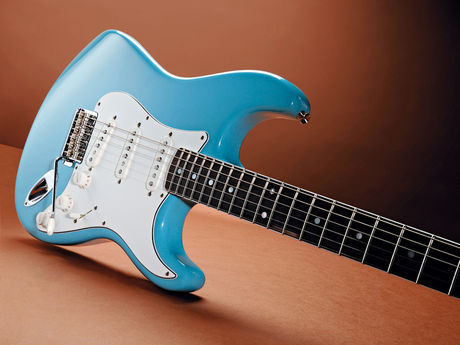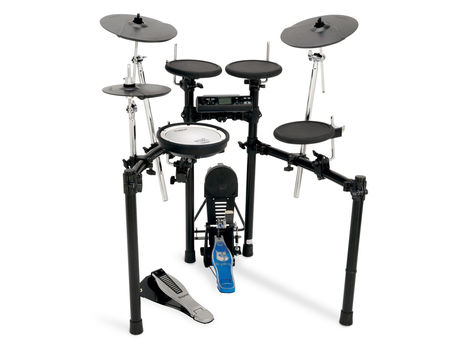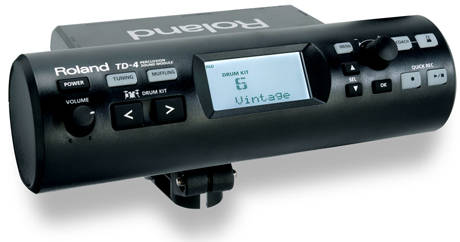Neville Marten, Thu 5 Mar 2009, 4:10 pm GMT

Any mention of Eric Johnson invariably – and perhaps rather tediously for Johnson himself – concentrates on his status as a tone-hound of legendary credentials.
It will inevitably state how he goes through his equipment microscopically, making sure the polarity of each internal component faces the same direction so the current passes as smoothly as possible. Mention is unfailingly made of his preference for battery power over mains, while his predilection for Duracell is reiterated.
Thankfully, writers do then go on to talk about his astounding musicianship and an almost unfeasible knowledge of what makes great guitar tone. But sometimes it's forgotten just how into guitars and amps Johnson truly is – to the point where he probably knows as much about Strats as the people at Fender, and could likely give Marshall's amp engineers a run for their money.
"Even though you'll need to re-learn how to use a Strat to some extent, we can heartily recommend it."
Most importantly, some ignore the fact that Johnson's love for detail is never for the sake of it, but to extract the last drop of musicality from whatever equipment he chooses. So a signature Stratocaster, spec'd to Eric's exact requirements and built by Fender – whose reputation for quality is currently better than it's ever been – warrants close inspection here.
Of course this isn't the first EJ Signature Strat. We loved Eric's original, all-maple-neck model for its balance of vintage vibe and modern playability.
We were bowled over by the attention to detail that Johnson personally brought to bear over all aspects of its design and production; the two-piece alder body with deeply scooped contours, the delightfully smooth neck-to-headstock shaping and the thin-skin nitrocellulose finish.
All these features from the previous instrument have been retained for the current one. Others that have also been carried over include the slimmer headstock design and staggered-height tuner posts that negate string trees; Johnson-voiced pickups with a tone control on the bridge single-coil; and no vibrato cavity cover – Eric reckons they sound better without it and who are we to argue?
Of course, the main point of the new model is that it comes with a rosewood fretboard – a result of requests from players. But Johnson stipulated that other changes would be needed if a rosewood version were to be produced. Visual changes include a white three-ply pickguard with countersunk pickup height adjustment screws: the 'right' choice for classic '60s Strat aesthetic.
Rather than go for the classic 'slab' fingerboard originally introduced in 1959, Eric has chosen the 'round laminate' that Fender switched to around 1963. At the time slab 'boards were deemed too 'dark' sounding, so the use of a thinner slice of rosewood over a pre-cambered maple neck addressed the problem to Leo's satisfaction. Some people say that it also made for a more stable assembly.
The prime visual detail about the new guitar is the fact that the 'board is bound – the most famous bound-necked Strat being the blue one owned by Ry Cooder. Apparently, the reason that Strats briefly sported bound necks during the mid-sixties was because the model shared an identical neck to the Jazzmaster (around this time both were code number 13).
And when the Jazzmaster switched to an edge-bound, dot-inlaid rosewood 'board it made sense to Fender's new owners, CBS, for the Stratocaster to follow. Before long the Jazz changed again, to block inlays, and so the Strat reverted to the more classic unbound look.
What's not immediately apparent is that the guitar's fingerboard has a flatter, 12-inch (305mm) radius. That's the same as a Gibson Les Paul and, therefore, markedly different to Fender's vintage-style 7.25-inch (185mm) camber, which can make string bends choke out and enforce an unwieldy action.
Frets are medium jumbo and have been seated, profiled and polished to perfection. Their ends overlap the binding but there's no hint of sharpness: this is an exceptional fret-job. Position marker dots are real pearl and add that final touch to what is already a very classily put-together guitar.
In playability and set-up terms, a guitarist with Johnson's extraordinary facility requires perfection. Nothing less could handle his speed and articulation. And so it is that our EJ is flawlessly set up.
With all five vibrato springs installed the bridge lies flat on the body and the action is set low for speed, but with enough purchase to allow for positive string bends and vibrato. It would certainly go lower should that be your personal preference, but we'd happily leave it as it came.
With its slight 'V' profile the quarter-sawn maple neck feels modern – it's the fingerboard's flatness that does it. Ibanez comparisons are odious though; this is a Fender through and through, and yet it feels like no other Strat we've played – not even the previous Johnson model. It's super-slick, extremely fast and, above all, totally capable at playing anything and everything.
Sounds
When we reviewed his first signature guitar Eric told us that he had voiced the pickups – especially the bridge unit – even brighter than usual.
Now that's surprising at first; but when you consider Johnson's non-lead work – which often consists of super-bright, chorused, delayed and often harmonically complex chords – it starts to make sense.
Then bring in the tone control on that bridge pickup – back it down to halfway or even further and pile on the overdrive – and Eric's 'violin' tones emerge already fully formed.
It makes for a completely different Strat experience. Clean, all of the settings seem to provide exaggerated versions of the expected sounds, but get used to using the neck and bridge pickup tone controls and you'll never go back. Even though you'll need to re-learn how to use a Strat to some extent, we can heartily recommend it.
The Johnson's broader extremes of tone make it an extremely versatile guitar, and with the middle pickup's lack of tone control there's an extra funky edge to be had with it on its own, or in tandem with either of the other two. It's really hard to argue with Johnson's logic.
Reviewers ponder over the verdict of their musings for days before a piece is finished. Who is the guitar for? Who will like it? Does it fulfil its stated remit? Is it what it says on the tin – or less, or even more?
It might have been easy to conclude that the rosewood 'board version of Eric Johnson's signature guitar is for players who like the idea of Strats but prefer playing Gibsons. But the EJ doesn't play like a Gibson; it plays like a Fender, but a Fender with an even flatter fretboard than the 9.5-inch radius of many guitars in its current range.
Without resorting to active electronics or humbuckers, Fender and Johnson have managed to broaden the Strat's tone at both ends of its sonic spectrum, giving dark, tight distorted sounds and huge clean or chorused chords. It's flawlessly made, albeit knocking very serious money thanks to the current US Dollar exchange rate.
Eric Johnson is a charming and intelligent man, and a sophisticated guitarist capable of playing almost anything extraordinarily well. The fact that his new signature Fender is designed on exactly these premises and succeeds on every intended level, probably says as much as we need to.
Verdict
When a musician of EJ's calibre puts his stamp on the best electric guitar design of all time, every serious player needs to check it out!








